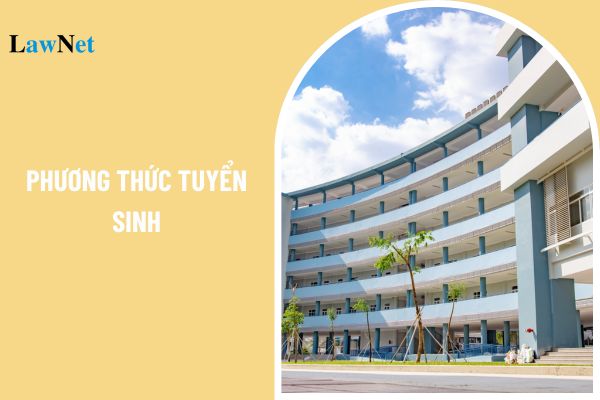What are the enrollment methods of Ho Chi Minh City Banking University in 2025?
What are the enrollment methods of Ho Chi Minh City Banking University in 2025?
On February 7, 2025, Ho Chi Minh City Banking University (HUB) announced its Enrollment Scheme for 2025. The university plans to apply 4 enrollment methods in 2025, including:
- Method 1: Direct admission and priority admission according to the regulations of the Ministry of Education and Training.
- Method 2: General assessment of results and achievements in upper secondary education.
- Method 3: Admission by high school graduation exam scores.
- Method 4: Admission by V-SAT results.
Particularly for programs with degrees issued by international partners, the university will conduct enrollment through academic records combined with interviews. Among the above methods, the university will consider comprehensive assessments and V-SAT scores before high school graduation exam scores are available, meaning early admission will be held.
Download the Enrollment Scheme of Ho Chi Minh City Banking University for 2025

What are the enrollment methods of Ho Chi Minh City Banking University in 2025? (Image from the Internet)
What are the state policies on development of higher education in Vietnam?
The State policies on development of higher education in Vietnam are stipulated in Article 12 of the Higher Education Law 2012 amended by Clause 7 of Article 1 of the Law on Amendments to Law on Higher Education 2018 as follows:
1. Development of higher education is meant to develop high quality human resources, meet socio-economic development requirements and ensure national defense and security.
2. Funds and resources shall be given to development of higher education on principles of competitiveness, equality and efficiency through investment in research and development (R&D) investment, signing research and training contracts, offering scholarships, student credit and other forms.
Higher education development will be given certain privileges and incentives in terms of land, tax, credit and other policies.
3. Prioritize investment in development of certain regional and international higher education institutions, academic disciplines and teacher training institutions; develop some special academic disciplines and higher education institutions capable of achieving strategic national and regional objectives.
Encourage rearrangement and merger of universities into parent universities; apply technology to higher education.
4. Seek private investment in higher education; encourage development of private higher education institution; give priority to non-profit private higher education institution; provide incentives for organizations and individuals that invest in education and training, science and technology activities in higher education institutions; grant tax exemption or reduction to property that are donated to serve higher education, given as scholarships or participation in student credit programs.
5. Introduce uniform policies to ensure autonomy and accountability of higher education institutions.
6. Ensure relation between training and demand for labor; research into application of science and technology; enhance cooperate between higher education institutions, enterprises and science and technology organizations; provide tax incentives for science and technology products of higher education institutions; encourage organizations and enterprises to facilitate students and lecturers to improve practical skills, participate in internship, scientific research and technology transfers in order to improve training quality.
7. Attract, employ lecturers and provide benefits for lecturers in order to improve their quality; focus on increasing the quantity of lecturers that are masters, doctors and leading professors in higher education institutions.
8. Give priority to people eligible for social benefits (hereinafter referred to as “disadvantaged people"), people in extremely disadvantaged areas and students in special academic disciplines in order to ensure adequate human resources for socio-economic development; ensure gender equality in higher education.
9. Encourage and intensify international integration and cooperation in order to raise Vietnam’s higher education to regional and international levels.
What are the basic principles of enrollment for undergraduate programs in Vietnam for 2025?
Under Article 4 of the Regulations on enrollment for undergraduate and college programs in Early Childhood Education issued with Circular 08/2022/TT-BGDDT, the basic principles of enrollment for undergraduate programs for 2025 include:
- Fairness to candidates
+ Regarding provision of information: Each interested candidate is provided with complete, clear, reliable, consistent, and prompt information to make suitable decisions and best prepare for participation in enrollment;
+ Regarding application opportunities: No candidate loses the opportunity to apply due to rules unrelated to educational level or ability (except for special regulations by the Ministry of Public Security and Ministry of National Defense related to national defense and security); or due to cumbersome, costly admission processes;
+ Regarding ability assessment: Candidates must be evaluated objectively, fairly, and reliably about their academic potential and success prospects, meeting the requirements of the program and field of study;
+ Regarding admission chances: Candidates must be given the highest chance of admission and the right to determine their order of preference among qualified programs and fields of study;
+ Regarding fulfillment of commitments: Training institutions must fulfill commitments to candidates; provide advice, and support, and resolve complaints, protecting the legitimate rights of candidates in risk situations.
- Equality among training institutions
+ Regarding cooperation: Training institutions cooperate equally to enhance the quality and effectiveness of enrollment, thereby providing the best benefits for candidates;
+ Regarding competition: Training institutions compete honestly, fairly, and healthily in enrollment according to the competition law.
- Transparency to society
+ Regarding information transparency: Training institutions are responsible for announcing full, clear, and promptly admission information through appropriate media to allow society and state management agencies to oversee;
+ Regarding accountability: Training institutions are responsible for reporting upon request by state management agencies and properly explaining to society about major issues causing public concern.

